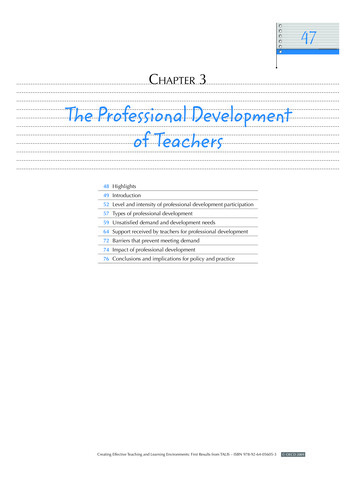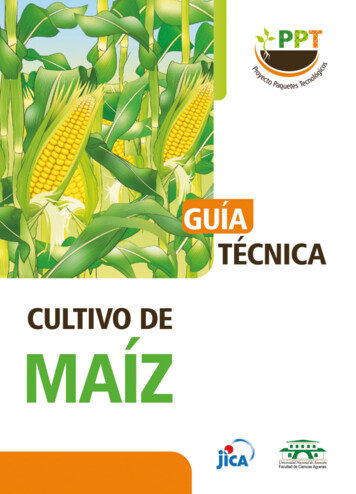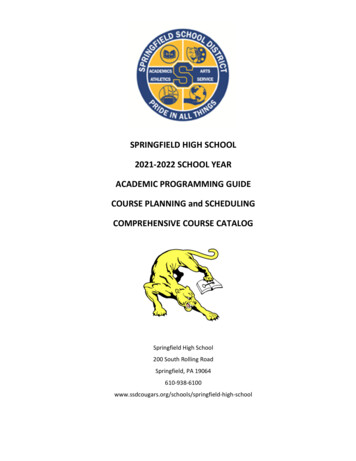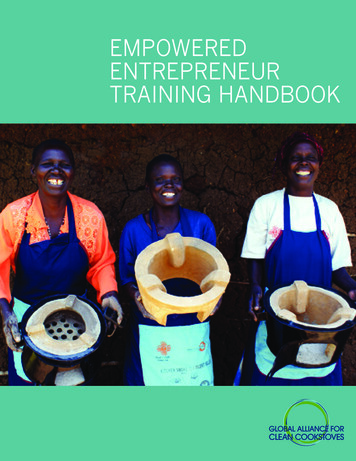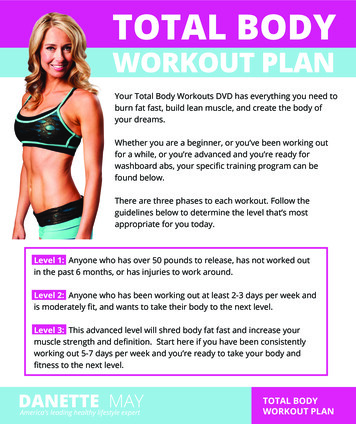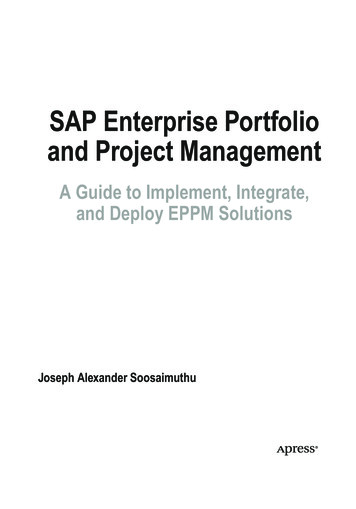
Transcription
REENTRYPLANNINGTOOLKITfor people in reentry &people with arrest andconviction recordsRoot & Rebound 2018
about root & rebound’sprograms and servicesRoot & Rebound is a non-profit reentry legal resource and advocacy center. Our mission is to increase access tojustice and opportunity for people in reentry from prison and jail and people with records, and to educate andempower those who support them. We offer statewide resources and programs, which are summarized below. Visitour website at rootandrebound.org, or call 510-279-4662, to learn more.TOOLKITSOur Reentry Planning Toolkits are concise reentry planning guides tailored to the different audiences that rely onthem. They contain key know-your-rights information, planning tools and checklists, and information around gainingID, voting rights, navigating the employment search, family reunification, education, parole and probation issues,record-cleaning, and other key reentry issues. Our cost structure is as follows: 1) Reentry Planning Toolkit for People in Reentry & People with Records: FREE. By contactingRoot & Rebound requesting reentry legal resources, currently incarcerated people and people with prior justicesystem involvement will be offered this Reentry Planning Toolkit for free. (Donations are always welcome; noamount is too small.) 2) Reentry Planning Toolkit for Family Members with a Loved One in Reentry: FREE. Bycontacting Root & Rebound, family members with a loved one in reentry will be offered this Reentry PlanningToolkit for free. (Donations encouraged, no amount is too small.) 3) Reentry Planning Toolkit for Service Providers Supporting People in Reentry: Cost: 10each.We also offer special topic-specific toolkits: California Employers’ Fair Chance Hiring Toolkit: This Toolkit is ideal for employers and workforcedevelopment professionals to learn about the benefits, best practices, and legal requirements around hiringpeople with conviction histories. Cost: 10 each. “My Education, My Freedom”: A Toolkit for Formerly Incarcerated and System-ImpactedStudents Pursuing Education in California: FREE to individuals who are currently and activelyseeking to go back to school/enroll in college; 10 for all others.All Toolkits are available to order online at rootandrebound.org/roadmap, or by calling us at 510-279-4662.ROADMAP TO REENTRY LEGAL GUIDEFor case-specific questions, the Roadmap to Reentry Legal Guide is an encyclopedic resource for navigating the legalimpact of a criminal record on housing, employment, family, parole and probation issues, getting ID, and more. Accessour searchable website of the Roadmap to Reentry at roadmap.rootandrebound.org. For a paper copy of theguidebook, the cost is as follows: If you are currently incarcerated: FREE to check out from your institution’s library. If there is no copy in your institution’slibrary, call us any Friday at 510-279-4662 from 9 a.m. – 5 p.m. PST (we accept collect calls); write usat Root & Rebound, 1730 Franklin Street, Suite 300, Oakland, CA 94612; or ask someone to email us atroadmap@rootandrebound.org on your behalf, and we will be sure to send one to the institution. If you want your own copy of the book, the cost is 20. Someone can order this on your behalfby calling Root & Rebound at 510-279-4662 or ordering online at rootandrebound.org/roadmap. For everyone else: FREE to view or download a PDF of the guide at rootandrebound.org/roadmap FREE to access the searchable website of the guide at roadmap.rootandrebound.org If you want your own copy of the book, the cost is 39. Order by phone at 510-279-4662 oronline at rootandrebound.org/roadmapHOTLINERoot & Rebound runs the only statewide Reentry Legal Hotline in the country where currently and formerlyincarcerated people and people with conviction histories, their family and loved ones, and service providers can calland speak to a reentry attorney for free. Call the Hotline any Friday, 9 a.m. - 5 p.m. PST, at phone number 510-2794662. Please note: If you are currently incarcerated and do not have phone access, you can write usconfidential, legal mail at: Root & Rebound, 1730 Franklin St., Suite 300, Oakland, CA 94612 (ATTN: KatherineKatcher, SBN 295448).Page 1 of 102
CLINICSRoot & Rebound offers in-person legal clinics statewide, where people with records can sign up for a one-on-oneappointment with a member of our legal team. We focus our clinics on issues and regions that are the mostunderserved, including in rural communities, with our tribal partners, and focusing on issues like family law, paroleand probation, record-cleaning, and other hard-to-access legal services for people with past justice systeminvolvement.TRAININGSPublic education being critical to Root & Rebound’s mission, we offer community-based and prison- and jail-based‘know-your-rights’ trainings. As a small team of attorneys, our trainings allow us to share important reentry legalknowledge statewide with directly impacted people and service providers, and in turn learn directly from people on theground about the most pressing needs for people with records in their community. We also partner with communityorganizations and government agencies to bring Root & Rebound’s legal trainings, direct services, and curriculum intoour partners’ services, improving the outcomes for their clients.CONTACT US: If you have any questions, please call us at 510-279-4662, email us atinfo@rootandrebound.org, or write us at 1730 Franklin Street, Suite 300, Oakland, CA 94612.DONATE: If you find value in this Reentry Planning Toolkit and Root & Rebound’s work, please considerdonating at rootandrebound.org/donate to help us continue offering our free resources and trainings offered tocurrently and formerly incarcerated people and their loved ones.DISCLAIMERWHEN PUTTING TOGETHER THIS TOOLKIT, ROOT & REBOUND DID ITS BEST TO OFFER HELPFUL ANDACCURATE INFORMATION FOR INDIVIDUALS IN REENTRY AND INDIVIDUALS WITH CONVICTIONRECORDS. HOWEVER, WE CANNOT UPDATE THIS TOOLKIT EVERY TIME THERE IS A CHANGE IN LAW ORPOLICY, AND IT IS YOUR RESPONSIBILITY TO MAKE SURE THE LAW HAS NOT CHANGED AND APPLIESTO YOUR INDIVIDUAL SITUATION.THIS TOOLKIT IS NOT INTENDED TO GIVE LEGAL ADVICE, BUT RATHER GENERAL LEGAL INFORMATIONABOUT PEOPLE’S RIGHTS IN REENTRY. IF YOU NEED LEGAL ADVICE, YOU SHOULD CONSULT YOUROWN ATTORNEY.ROOT & REBOUND OFFERS THIS TOOLKIT “AS-IS” AND MAKES NO REPRESENTATIONS ORWARRANTIES OF ANY KIND CONCERNING THE TOOLKIT, EXPRESS, IMPLIED, STATUTORY OROTHERWISE, INCLUDING, WITHOUT LIMITATION, WARRANTIES OF ACCURACY, COMPLETENESS, TITLE,MARKETABILITY, MERCHANTABILITY, FITNESS FOR A PARTICULAR PURPOSE, NONINFRINGEMENT, ORTHE PRESENCE OF ABSENCE OF ERRORS, WHETHER OR NOT DISCOVERABLE.IN PARTICULAR, ROOT & REBOUND DOES NOT MAKE ANY REPRESENTATIONS OR WARRANTIES THATTHE TOOLKIT, OR ANY INFORMATION IN THE TOOLKIT, IS ACCURATE, COMPLETE, OR UP-TO-DATE ORTHAT IT WILL APPLY TO YOUR CIRCUMSTANCES.“The greatest glory in living lies not in neverfalling, but in rising every time we fall.”– Nelson MandelaPage 2 of 102
authors & contributorsROOT & REBOUND’S TEAM: Thomas Alexander,AmeriCorps VISTABriana Barnes, OperationsCoordinatorElliott Chadwick, LegalAssistantRémy De La Peza, Director ofNational InitiativesCarmen Garcia, Director ofFinance & AdministrationLizzy Gilbert, Director ofCommunity Resources Rashida Harmon, ReentryLegal ConsultantAdriana Hazou, AmeriCorpsVISTAEmily Juneau, ReentryAttorney & Manager of StatewidePartnershipsAiasha Khalid, DeputyDirector - Strategy & ImpactKatherine Katcher, Founder& Executive DirectorLaura Merchant, Manager ofDirect Services Cara Palanca, Coordinator,Community Engagement andPartnershipsFaride Perez-Aucar, LawClerkCal Smith, AmeriCorps VISTAK.C. Taylor, Reentry Attorney& Manager of Bay AreaPartnershipsSonja Tonnesen, DeputyDirector - Programs &PartnershipsDeric Washington, Law ClerkPARTNERS & CONTRIBUTORS:Thank you to our partners for reviewing and co-developing content for the first version of this Toolkit: Carl B. Metoyer Center for Family Counseling, which provides culturally responsive family counseling,case management and crisis intervention services to youth and families of East Oakland. Since 1978, the Centerhas specialized in working with youth who are struggling at home, at school, and involved in the juvenilejustice system, many of whom are impacted by the incarceration of a loved one. Parent Caregiver Advisory Group (PCAG), which is a workgroup of the Alameda County Children ofIncarcerated Parents Partnership (ACCIPP). The workgroup is made up of a diverse group of caregiversand formerly incarcerated parents who provide insight, consultations, and advisement on reentry matters thatimpact children and families. If you or someone you know in Alameda County might be interested inparticipating in PCAG, please contact Kimberly Murphy of A Better Way, Inc. at (510) 318-4502.We would also like to thank the following advisors and contributors: Irina Alexander, Maria “Alex” Alexander, DinaAlkhoury, Bridget Ambrose, Michael Bays, Sarah Carson, Daisy Chavez, Crystallee Crain, Arkeuria Davis, RonaldDavis, Armondo DePina, Kyle Dunson, Josh Elliot, Ronell Ellis, Ivy Harris, Clarence Henderson, Joseph Hess, ShawnGarety, Rob Gitlin, Sandra Johnson, Sam Lewis, Marnie Lowe, Pamela Mchombo-Taylor, Jean Milam, KimberlyMurphy, Marvin Mutch, Zachary Newman, Bikila Ochoa, Blair James, Melinda Jones, Marvin Jordan, Natalie Siva,Douglas Smith, Deborah Thorpe, and Briana Zweifler.THANK YOU!This Toolkit would not have been possible without the contributions, inspiration, and resilience of people directlyimpacted by the criminal justice system and their family members. Thank you for your tireless advocacy fora better, fairer world. A special thank you to the Zellerbach Family Foundation (ZFF) for making this Toolkitpossible and for its work to give all Bay Area families access to justice and opportunity. We thank ZFF immensely for itsgenerous, continued support of Root & Rebound’s work to support families and individuals impacted by the criminaljustice system.about the toolkitWhy did Root & Rebound create this Reentry Planning Toolkit?The main goal of this Toolkit is to help individuals in reentry from prison and jail and people with arrest and convictionrecords develop an individualized reentry plan and learn about their legal rights along the way.The Toolkit provides answers to key questions such as: “What are my rights with a criminal record? Where do I start?Who can help? When should I start?” It also provides practical tools—important information, action steps,questionnaires, checklists, tips, referrals, and resources—that can guide you through common questions inreentry and help you find the answers and support you seek.Page 3 of 102
Who is this Toolkit for?This Toolkit is designed for people in reentry and people with prior justice system involvement. A criminalrecord is often a barrier to the most important things in life: housing, employment, family reunification, health care,education, and even getting basic forms of identification documents (ID). We created this Toolkit to provide you withinformation about your legal rights and helpful tools and resources. We hope this information allows you to tap intoyour inner advocate and strengths, enabling you to thrive and move beyond your system involvement.We have created three different versions of the Reentry Planning Toolkit. If you have a family member/lovedone OR service provider supporting you, they can order a version of the Toolkit designed specifically forthem by emailing Root & Rebound at roadmap@rootandrebound.org, or calling us at (510) 279-4662.Who wrote this Toolkit?The writing of this Toolkit was a joint, collaborative effort between Root & Rebound’s legal team,individuals and family members directly impacted by incarceration, and service providers whosupport people with past involvement in the criminal justice system.Even before we began writing, Root & Rebound’s team met with, interviewed, and surveyed currently and formerlyincarcerated people and their family members and loved ones about the issues that impacted them the most. We alsoreviewed the most frequently asked questions that come to us through our Reentry Legal Hotline, clinics, and otherprograms, so that we could include know-your-rights information about the most common reentry legal barriers.Our partners include groups whose members are directly impacted by incarceration. As directlyimpacted experts, they offered critical insight on the topics in this Toolkit, and wrote and edited content outside thescope of Root & Rebound’s expertise including: important issues to keep in mind when (re)building relationships (pg.13); therapy and support (pg. 14); and preparing for job applications & interviews (pg. 40). This Toolkit is richer andmore useful because of the many hours that currently and formerly incarcerated people, their families, and theiradvocates poured into this resource. Thank you to all!Do I need anything else to use this Toolkit?If you have specific legal questions about the impact of your criminal record onthings like housing, employment, family reunification, parole and probation, votingrights, getting ID, public benefits, health care, or immigration status that go beyondthe issues discussed in this Toolkit, Root & Rebound offers additional resources thatmay help answer your questions, including the Roadmap to Reentry LegalGuide.The Roadmap to Reentry: A California Legal Guide—available in print andonline—is an encyclopedic “know-your-rights” legal guide that individuals inreentry, their family members, advocates, and service providers use across the stateof California to answer their questions about navigating the legal impact of acriminal record on housing, employment, family reunification, parole andprobation issues, getting ID, voting, immigration, and more. Learn how to view ororder a copy on pg. 1.While our Reentry Planning Toolkits are like “mini-guides” tailored to specific userswith the most important information pulled from the Roadmap to Reentry afteryears of feedback, the original Roadmap to Reentry guide is more accessible than ever for comprehensive informationon everything reentry law related in California.To learn more about all of Root & Rebound’s resources and services, read the information about our statewideprograms and services starting on pg. 1; call Root & Rebound at 510-279-4662; or email us atinfo@rootandrebound.org.When and how should I use this Toolkit?It is never too early to plan for reentry! And it is never too late to learn more about your rights living with a record! If you are currently incarcerated, we recommend that you begin planning for your reentry and workingthrough this Toolkit at least 1 year before release from prison or jail, if possible. If you are formerly incarcerated or living with a record, parts of this Toolkit will likely be useful to youPage 4 of 102
now. We did our best to explain throughout the Toolkit when information would be more relevant dependingon how long ago you were involved with the criminal justice system. Even if you’ve never been incarcerated,but have an arrest or conviction record, certain parts of this Toolkit can help you to learn about your rights!If you are not sure what to read first, here are some suggestions: To begin, review the Table of Contents on pg. 6 tounderstand all the topics covered in the Toolkit. This can also help you identify topics you are looking for moreinformation on. Next, review the Timeline on pg. 10 to get a better idea of where you are now and identify key stepsyou can take. Each section of the Toolkit has a cover page that summarizes the information you can learn about there.Each section also has questions and checklists you can fill out as you go. Finally, Appendix E (pg. 94) includes aSample Reentry Plan that you can write in, rip out, or start with before you jump into the Toolkit!While this Toolkit includes general tips and information, remember that the reentry process and the impact ofhaving an arrest or conviction record looks different for everyone. Use this Toolkit as needed. If you alreadyknow something or if information does not apply to you, feel free to skip that section. There is no “right” or “wrong”here—there is only information meant to help you know your rights and plan ahead.KEY ICONS IN THE TOOLKITTo make this Toolkit easier to use, we have provided a list of key icons that pop up throughout as you read. In theboxes next to these icons, you will find additional information that you should be aware of.ICONMEANINGCONSULT A LAWYER: If you believe your rights may have been violated, talking to a lawyer can be veryhelpful for professional consultation and legal support. As a first stop, Root & Rebound offers a ReentryLegal Hotline every Friday from 9 a.m. to 5 p.m. PST at phone number (510) 279-4662, where anyonewith a reentry-related question can call and speak to a member of our legal team.LEARN MORE IN THE Roadmap to Reentry Legal Guide: For individual reentry issues not coveredin this Toolkit, check out our Roadmap to Reentry Legal Guide, a comprehensive legal reference guide forpeople in reentry and those who support them. Visit the searchable website of the Roadmap to Reentry atroadmap.rootandrebound.org, or order a hard copy of the guidebook at www.rootandrebound.org. Learnmore about Root & Rebound’s resources, programs, and services starting on pg. 1 above.ACTION STEP! The information after a star symbol provides concrete next steps in your reentry journey.IMPORTANT INFORMATION OR WARNING! The particulars of your arrest or conviction history andother personal circumstances can have a big impact on your legal options and outcomes. This icon warns youof individual-specific issues that require you to be extra careful.REENTRY PLANNING TIPS: This icon indicates tips that can help you as you plan for your reentry andadvocate for yourself.HELPFUL RESOURCES: This icon identifies other organizations and resources that may be able tosupport you in reentry.WE ARE A FREE RESOURCE. WE ARE HERE TO HELP.For individual questions, you can call Root & Rebound’s free Reentry Legal Hotline any Friday, 9 a.m. - 5 p.m.PST at (510) 279-4662 (we accept collect calls); email roadmap@rootandrebound.org; or write confidential, legalmail to Root & Rebound, 1730 Franklin St., Ste. 300, Oakland, CA 94612 (ATTN: Katherine Katcher, SBN: 295448).Page 5 of 102
table of contentsHERE IS A SUMMARY OF THE INFORMATION COVERED IN EACH SECTION OF THE TOOLKIT.Glossary of Terms (p. 7)Part 1—Introduction to Reentry Planning: Starting Over Strong (p. 9)Part 1 covers what “reentry” is, key terms, reentry planning tips and resources to help you start over strong,information about seeking support and services while incarcerated, and tips about rebuilding relationships withfamily and loved ones in the early days out.Part 2—Getting Official ID & Useful Items Set Up for the Early Days Out (p. 16)Part 2 covers how to get identification documents (ID) and other important resources for the early days out.Part 3—Voting Rights (p. 23)Part 3 covers voting rights in California based on your incarceration or supervision status.Part 4—Creating a Housing Plan (p. 26)Part 4 covers various housing options post-release, what you need to know if you will be staying with family, how tocreate a plan for finding both short- and long-term housing, and challenging illegal denials to housing.Part 5—Creating an Employment Plan (p. 37)Part 5 covers what you need to know to rejoin the workforce and how you can create a plan for finding a job.Part 6—Continuing Education in Reentry (p. 45)Part 6 covers a basic summary of various educational pathways and levels, and important information for goingback to school.Part 7—Adjusting to Life on Community Supervision: Parole, Probation & Federal Supervision (p. 50)Part 7 covers what community supervision is, how it will impact your daily life, and what it can mean for family.Part 8—Managing Court-Ordered Fines & Fees (p. 57)Part 8 covers best practices for you to take control of and/or reduce court-ordered fines and fees related to a pastcriminal case.Part 9—Record-Cleaning (p. 60)Part 9 covers general information about RAP sheets and potential options for cleaning up your record with thesupport of a “clean slate” legal clinic and reentry lawyers.Part 10—Setting Up Public Benefits & Health Care (p. 67)Part 10 covers what public benefits might be available to you and other key information about health care in reentry.Part 11—Family Law Issues & Child Reunification (p. 74)Part 11 covers key know-your-rights information for staying connected with family members while incarcerated andfor parents navigating the court system to reunify with their children.Part 12—Reentry Resources for Immigrants (p. 80)Part 12 covers key information for noncitizens with arrest and conviction records who need legal support.APPENDICES: Appendix A: List of Legal Aid Referrals Across California (p. 86)Appendix B: List of Reentry Organizations Across California (p. 89)Appendix C: Immigration Support Referrals (p. 91)Appendix D: Transitional Housing Providers that Accept Applications from Currently Incarcerated People (p. 92)Appendix E: Sample Reentry Plan (p. 94) - Please find a sample Reentry Plan for you to fill out based on youranswers throughout the Toolkit.Page 6 of 102
glossary of termsThe following glossary provides basic definitions for commonly used terms related to the criminal justice systemand criminal records. Infraction: A violation of a rule or local ordinance, usually punishable by a fine rather than by incarceration.Examples include traffic (or “moving”) violations, disturbing the peace, and failure to appear.Misdemeanor: A minor crime usually punishable by a fine and/or confinement in a place other than prison, suchas county jail. Examples include driving under the influence (DUI), petty theft, solicitation for an act of prostitution,and shoplifting.Felony: A major crime usually punishable by imprisonment for more than one year or by death. Examples includeburglary, arson, rape, certain drug crimes, and murder. Felonies can be—but aren’t always—classified as serious orviolent. These classifications can be important, as they dictate whether a crime counts as a strike under California’sThree Strikes Law. They also may impact a person’s ability to be released early.Arrest: Occurs when law enforcement apprehends or restrains the movement of a criminal suspect against his orher will. An arrest does not necessarily lead to a person being charged with a crime or taken to jail. However, even ifthey are not prosecuted, an arrest will show up on a person’s criminal record.Charge: To formally accuse a person of an offense. At this stage, a District Attorney or prosecutor has the choice todrop (or “dismiss”) charges, or move forward with criminal prosecution in court.Bail: The sum of money required to release a person from jail or prison while charges are pending against them, orwhile they are being tried, in order to guarantee their appearance in court.Conviction: A judgment, made in court by a jury or judge, stating that a person is guilty of a crime.Plea: An accused person’s formal response to a criminal charge, limited to a plea of guilty, not guilty, or no contest.A plea of no contest is treated exactly like a guilty plea for criminal purposes.Sentence: The punishment imposed by a court on a person convicted of a crime. See definitions below for detaileddescriptions of common types of sentences.House Arrest: When a person is confined to a residence as an alternative to jail or prison time. Travel is usuallyrestricted.Ankle Monitor: A device that people under house arrest, or on parole, are required to wear that monitors theirlocation.Jail: A local (usually county-level) government’s detention center, which holds people awaiting trial, peopleconvicted of misdemeanors, or people convicted of felonies but sentenced under Realignment (see below).Prison: A state or federal confinement facility for people convicted of crimes, especially felonies. The CaliforniaDepartment of Corrections and Rehabilitation, commonly abbreviated as CDCR, oversees the state prison system.Realignment: In 2011, Governor Jerry Brown signed the Public Safety Realignment Act in an effort to reduce thenumber of inmates funneling into overcrowded state prisons. Realignment allows non-violent, non-serious, non-sexoffenders to serve their sentences in county jail instead of prison.Parole: A condition of release for a person coming out of state prison. People on parole (sometimes called“parolees”) remain under the control of the CDCR and must adhere to a set of rules (called “conditions”) designed topromote a crime-free life. To ensure compliance with these rules, people on parole are required to check in with aParole Officer (“P.O.”) or Agent employed by the CDCR’s Division of Adult Parole Operations (DAPO) atdesignated intervals.Probation (county-level): A criminal sentence served in the community in place of—or following—a jailsentence. People on county probation must adhere to a set of rules (known as “conditions”) designed to promote acrime-free life. There are different types of probation: some supervised by the court (called informal, summary, orcourt probation), and some supervised by a probation officer (called formal probation).Determinate Sentence: A sentence for a fixed length of time rather than an unspecified duration.Lifer: A person sentenced to life in prison who may eventually become eligible for release due to good behavior orproof of rehabilitation.LWOP: An acronym referring to people sentenced to life in prison without the possibility of parole. This meansthat, absent a remarkable event such as a government pardon or commutation of sentence, that person will never bereleased from prison.Strike: A conviction in California for “violent” or “serious” felonies.Record of Arrests and Prosecution, or “RAP” sheet: The government’s official version of an individual’scriminal record. It lists every contact an individual has had with the criminal justice system, including arrests,convictions, acquittals, dismissals, and sentences. These usually take one of three forms: a county RAP sheet (listingonly in-county contact with the criminal justice system), a California Department of Justice RAP sheet (listing allcontact with the state criminal justice system anywhere in California), or an FBI RAP sheet (listing all contact withPage 7 of 102
the federal criminal justice system and all contact with any state’s criminal justice system across the United States).Warden: The chief administrative officer of a prison who oversees prison operations, manages prison personnel,and supervises facility-wide safety and security compliance.Correctional Counselor: A prison staff member who works with incarcerated individuals, maintaining recordson their history, risk of re-offending, and managing their plans for transition from prison to parole or probation.Contraband: An item or items unlawfully brought into prison or jail. Possession of contraband can result in loss ofgood time credit. A visitor, staff member, or contractor who brings contraband into a prison or jail can face seriousfines and/or jail time.Board of Parole (BOP): The Board that is responsible for parole suitability hearings and nonviolent offenderparole reviews. This Board also assesses parole eligibility for incarcerated people who are elderly, have medicalproblems, or were youth offenders.California Department of Corrections and Rehabilitation (CDCR): The State department responsible foroperating California’s state prisons and parole systems. Prison staff and parole personnel are employees of CDCR.Private Background Check: A background check assembled by a private company, which draws from sourceslike court records, police, correctional, and CDCR records, other public records, Internet searches, andcommunication with people who know the applicant.In-house Background Check: A background check assembled by the employer, which draws from publicrecords, interviews with people who know the applicant, and online searches.Live Scan: A Live Scan is a comprehensive background check procedure that involves submitting an applicant’sfingerprints to either the California Department of Justice or to the Federal Bureau of Investigation. An applicantmay be required to Live Scan for many government jobs, jobs requiring security clearance, or as an element of anapplication for an occupational license.Petition for Writ of Habeas Corpus: The way for an individual in prison or on parole to ask a state or federaldistrict court to make a decision about the lawfulness of the individual’s detention or supervision.Page 8 of 102
part 1.INTRODUCTION TOREENTRY PLANNING:STARTING OVERSTRONGSUMMARY - PART 1.Part 1 provides: Information about what reentry is and tips for building a strong reentry plan; A suggested timeline for reentry planning; Resources for people who are currently incarcerated; and Information and resources to help with (re)building relationships with family & loved onesafter a period of incarceration.FIND MORE KNOW-YOUR-RIGHTS INFORMATION IN THE ROADMAP TO REENTRY LEGALGUIDE:Do you have individual questions about barriers related to reentry or involvement with the criminaljustice system that we did not cover in this Toolkit? Root & Rebound publishes and updates anencyclopedic, know-your-rights reentry legal guide called the Roadmap to Reentry. It is available online,in print, and for free in prison and jail libraries (where possible).SEARCH THE ONLINE GUIDE OR REQUEST A PAPER COPY: Search by key terms on oursearchable website of the Roadmap to Reentry Legal Guide at roadmap.rootandrebound.org. Downloadthe PDF or order a print copy at www.rootandrebound.org/roadmap, or by calli
them by emailing Root & Rebound at roadmap@rootandrebound.org, or calling us at (510) 279-4662. Who wrote this Toolkit? The writing of this Toolkit was a joint, collaborative effort between Root & Rebound's legal team, individuals and family members directly impacted by incarceration, and service providers who
